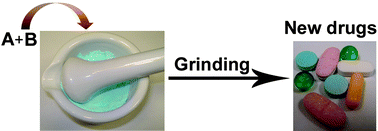The role of mechanochemistry and supramolecular design in the development of pharmaceutical materials
Abstract
The development of modern pharmaceutical solid forms, including solvates, polymorphs, salts or cocrystals, is related to the design and control of molecular self-assembly processes. Mechanochemistry has emerged as an excellent experimental approach to rapidly and efficiently screen for and synthesise such pharmaceutical materials. This is particularly the case for pharmaceutical cocrystals which are of considerable interest in the area of modern solid-state pharmaceutical materials science. Mechanochemistry has also been demonstrated as a successful technique to screen and synthesise metal–organic pharmaceutical derivatives (herein addressed as metallopharmaceuticals) as well as metallodrugs. The quantitative yields and high crystallinity of products obtained via mechanochemical synthesis enables the efficient coupling of solvent-free screening and structure determination from powder X-ray diffraction data to provide rapid advances in systematic studies and the structural understanding of pharmaceutical forms based on hydrogen bonding interactions or coordination bonds. In this review, we describe how mechanochemical methods have improved the development of new solid forms and their structural understanding, as well as the development of supramolecular strategies for the crystal engineering of pharmaceutical solid forms.

- This article is part of the themed collections: Crystal engineering and crystallography in the pharmaceutical industry and A celebration of 25 volumes of CrystEngComm

 Please wait while we load your content...
Please wait while we load your content...